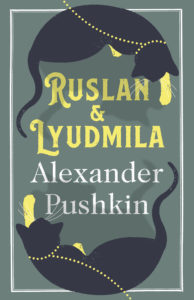 Pushkin was still in his teens when he wrote most of Ruslán and Lyudmíla. Though a fairy story, he wrote it not for children, but for youngsters of his age and for the literary avant-garde of St Petersburg.
Pushkin was still in his teens when he wrote most of Ruslán and Lyudmíla. Though a fairy story, he wrote it not for children, but for youngsters of his age and for the literary avant-garde of St Petersburg.
Set in ancient Russia at the time of Grand Prince Vladímir of Kíev, the tale opens with the wedding feast given by Vladímir for his daughter Lyudmíla and her bridegroom, the young knight Ruslán. But on the wedding night Lyudmíla is snatched from Ruslán’s side by the evil wizard Chernomór, who carries her off to his magic castle in the far north. Old Vladímir, furious with Ruslán for losing his beloved daughter, allows three rivals to set off with Ruslán in search of the girl, promising her in marriage to whichever of them returns her safe to Kíev.
Ruslán and Lyudmíla is a work that is easy, enjoyable and entertaining to read. Though written as a narrative poem in epic form, its style is racy and tongue-in-cheek. It’s a good story, fast moving, packed with inventive episodes, skilfully narrated in beautiful language and brilliant verse, full of charming description, humorous detail, genuine emotion, and ironic observation. It is also a poem of constant shifts of mood and style, but held together by Pushkin’s identity as narrator, commentator, and digressor; now involved, now detached; now serious, now joking; now lyrical, now ironic – a technique that he was soon to use again in his greatest work, the verse-novel Eugene Onégin.
Shortly after Pushkin’s death the Russian composer Mikhaíl Glinka used Pushkin’s poem as the basis of an opera, which had its first performance in St Petersburg in 1842. The libretto departs significantly from Pushkin’s story, and is much weaker both dramatically and psychologically. Of Glinka’s innovative and delightful music only the overture is regularly performed in the West.
Here I set myself to provide, in all respects but rhyme, an exact and faithful rendering into English of Pushkin’s Russian original. I have used the same metre as Pushkin, and the same number of lines. More importantly, it has been my aim to match Pushkin’s style and tone. Predominantly, I have set myself to reproduce in fluent and modern English Pushkin’s fluent and modern Russian. But, as Pushkin has varied the pitch of his language (as he constantly does) according to the effect he wants to produce – whether solemn, or serious, or polemical, or straightforward, or lyrical, or funny, or ironic – so I have tried to do the same.